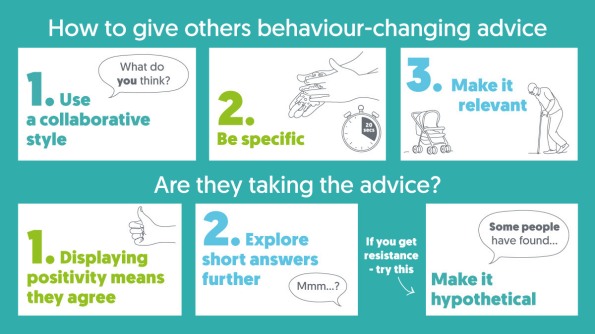March 25th, 2020: governments around the world require citizens to take increasingly stringent measures to combat COVID-19. In a rapid response to how Governments are communicating with us about how to limit the spread of the virus, Saul Albert and Charlotte Albury have compiled a report, based on a systematic review by a team led Albury, by on what CA can tell us about how medical advice is given and received.

Saul Albert, Loughborough University

Charlotte Albury, University of Oxford
Since the 12th March The UK government has been advising people to avoid large gatherings and to practice social distancing. However, until the announcement of enforcement measures on the evening of Monday 23rd March there were regular reports of markets and pubs thronging with people and supermarkets packed with shoppers. So why didn’t the government’s advice work? And how do you get people to change their behaviour in response to serious and urgent medical advice?
The COVID-19 pandemic is an unprecedented public health challenge, but when formulating a strategy for giving public health advice, there are important lessons from research into how doctors deliver life-saving health advice in everyday settings such as primary care consultations. Of course one-to-one GP consultations are completely different situations from watching political broadcasts or written advice, but what we know about the ordinary social practices of giving and receiving advice can indicate the most appropriate strategy for helping people adapt their behaviour to this unusual situation. Even with the enhanced restrictions announced by the government last night [March 23rd 2020], it is still crucial to use effective techniques to advise friends, family, and co-workers to adopt careful hand-washing and social distancing measures, to stay at home, and to take all steps to avoid spreading the infection.
How to give live-saving behaviour-change advice
Giving behaviour-change advice can be delicate at the best times, and during a global pandemic the stakes are particularly high. Make sure you use an up-to-date, trustworthy source for your advice. The NHS has a very clear overview of COVID-19 health guidance that you can use to inform your advice. There is also official guidance on permitted reasons for leaving your home during at least three weeks of near-lockdown. A research group led by Charlotte Albury, gathered together what we know about how physicians give behaviour-change advice in interaction This is what the review concluded about what is likely to be well-received and to lead to helpful discussions:
- Use a collaborative style of advice-delivery
The most important thing is to be collaborative during advice giving, particularly if your advice is unsolicited. Rather than immediately telling someone what they should be doing, instead invite their perspective (something like ‘so what do you think about social distancing?’) and then accommodate this throughout the conversation. We found that this strategy received responses that indicated receptivity to the advice being offered.
- Give specific risk-reduction advice
Advice about risks can seem daunting or scary without specific actionable things you can do to reduce those risks. For example, sharing a ‘worst case scenario’ to scare people into following advice is very unlikely to be received well, and vague unspecific advice doesn’t present any solutions. Instead, talk together about specific behaviours that reduce risk, such as hand-washing regularly and limiting social contact.
- Pin the advice to something relevant to the person
If advice doesn’t seem personally relevant for people, they’re probably not going to follow it. Different things are relevant to different people, and finding out what is important to a person means you can tailor advice to be personal, specific, and meaningful to that person and the situation they are going to face in everyday life.

You are welcome to share this graphic summary of behaviour-change advice, created by CARM and A Dozen Eggs.
How to tell if someone is taking advice, and what to try if they are not
In a health emergency, you don’t want to wait to find out if someone has followed your advice. Luckily, since advice-giving in interaction happens moment-by-moment, you don’t have to. Listening out for certain responses during the interaction will let you know how things are going.
- Elaborations & displays of marked positive stance (good)
Someone who shows they a responding positively to your advice (and may be agreeing) will go above and beyond neutrally acknowledging that you’ve spoken, and might elaborate further on what you’ve said, or display some positive assessment or acknowledgement, something like ‘Yes, I agree, I’ll probably stay in, like you said’ or ‘that sounds good’.
- Unelaborated acknowledgement tokens (bad)
If someone is responding with ‘unelaborated acknowledgement tokens’ (things like ‘mmm’ ‘right’ or ‘yeah’) at times in the conversation when it’s relevant for them to say a bit more, this could be a sign your advice has not been received positively. If you are noticing these sorts of responses, try and uncover the reason for resistance. It may be, for example, that the person doesn’t understand that individual behaviour can have such a strong effect in the current pandemic, and so your advice doesn’t make sense. If you can uncover the reason for resistance (such as disbelief, or lack of understanding), address and discuss it, before going back to advice-giving.
- If people take it personally, frame it as a hypothetical
For some people being told what they ‘should’ be doing can make them upset, or angry, as it implies they’re not doing the right thing at the moment. One way to get around this, but still have a productive discussion, is to talk hypothetically about ‘people in general’ rather than giving ‘advice for you’. For example rather than saying ‘you shouldn’t be going to other people’s houses’ you could try ‘Some people have found that Netflix party has been great to stay in touch whilst social distancing’.
Legal threat rather than advice
Now that the government’s initial advice-giving strategy has ended with the announcement of enforcement measures, it is worth reflecting on its shortcomings. The government frequently changed its advice, and highlighted worst-case scenarios while giving non-specific advice that left inconsistencies open to interpretation. Even after the announcement of enforced measures, open questions remain. For example, precisely which jobs are classed as non-essential? It is still necessary for everyone to do their bit and reach out to offer advice to friends and relatives. A carrier of COVID-19 infects around three people, so take it upon yourself to reach out to at least three people, offer them some well-designed advice, then encourage them to do the same.
Reference
Albury, C., Hall, A., Syed, A. et al. Communication practices for delivering health behaviour change conversations in primary care: a systematic review and thematic synthesis. BMC Fam Pract 20, 111 (2019). https://doi.org/10.1186/s12875-019-0992-x
